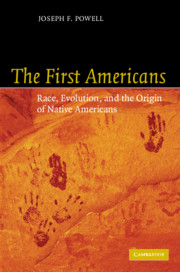Book contents
- Frontmatter
- Contents
- Acknowledgments
- Prologue: The Kennewick controversy
- PART I Race and variation
- 1 Debating the origins of Native Americans
- 2 A brief history of race
- 3 Evolutionary approaches to human variation
- 4 Recent population variation in the Americas
- PART II The Pleistocene peopling of the Americas
- PART III The First Americans, race and evolution
- References
- Index
1 - Debating the origins of Native Americans
Published online by Cambridge University Press: 21 August 2009
- Frontmatter
- Contents
- Acknowledgments
- Prologue: The Kennewick controversy
- PART I Race and variation
- 1 Debating the origins of Native Americans
- 2 A brief history of race
- 3 Evolutionary approaches to human variation
- 4 Recent population variation in the Americas
- PART II The Pleistocene peopling of the Americas
- PART III The First Americans, race and evolution
- References
- Index
Summary
But in the Southe parte of that contrey,
The people go nakyed always,
The lande is of so great hete!
In the North parte all the clothes
That they were is but bestes skynnes,
They have no nother fete;
But howe the people furst began
In that contrey, or whens they cam,
For clerkes it is questyon
John Rastell, Interlude of the Four Elements (1520) (in Huddleston, 1967: 110)EARLY EUROPEAN THOUGHT ON NATIVE AMERICAN ORIGINS
Some of the most perplexing questions in American prehistory concern how and when humans first colonized the New World. Since the sixteenth century, Americanist scholars have debated the origin of Native American peoples. In 1492, most scholars felt that Columbus had sailed to islands just off the coast of Cathay (Asia), so there was no need to question the origin of people he met in Hispañola: it was clear that they were Asians. However, by 1503, “[Amerigo] Vespucci had seen so much of the coastline of America (from Argentina to North Carolina) … that he became convinced it could not be Asia.” (Huddleston, 1967: 5). This prompted European speculation that the inhabitants were not therefore Asians. So who were they? How did humans get to the “New World”?
In the sixteenth century, putative answers came fast and furious, based on scanty evidence.
- Type
- Chapter
- Information
- The First AmericansRace, Evolution and the Origin of Native Americans, pp. 17 - 28Publisher: Cambridge University PressPrint publication year: 2005



